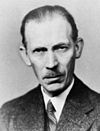From Wikipedia, the free encyclopedia
  |
|
| Johannes Nicolaus Brønsted and Thomas Martin Lowry, independently, formulated the idea that acids are proton (H+) donors while bases are proton acceptors. |
Definitions of acids and bases
In the Arrhenius theory acids are defined as substances which dissociate in aqueous solution to give H+ (hydrogen ions). Bases are defined as substances which dissociate in aqueous solution to give OH− (hydroxide ions).[1]In 1923 physical chemists Johannes Nicolaus Brønsted in Denmark and Thomas Martin Lowry in England independently proposed the theory that carries their names.[2][3][4] In the Brønsted–Lowry theory acids and bases are defined by the way they react with each other, which allows for greater generality. The definition is expressed in terms of an equilibrium expression
- acid + base
 conjugate base + conjugate acid.
conjugate base + conjugate acid.
- HA + B
 A− + HB+
A− + HB+
Aqueous solutions
Consider the following acid–base reaction, (also illustrated at top right)- CH
3COOH + H
2O CH
CH
3COO− + H
3O+
3COOH, is an acid because it donates a proton to water (H
2O) and becomes its conjugate base, the acetate ion (CH
3COO−). H
2O is a base because it accepts a proton from CH
3COOH and becomes its conjugate acid, the hydronium ion, (H
3O+).[6]
The reverse of an acid-base reaction is also an acid-base reaction, between the conjugate acid of the base in the first reaction and the conjugate base of the acid. In the above example, acetate is the base of the reverse reaction and hydronium ion is the acid.
- H
3O+ + CH
3COO− CH
CH
3COOH + H
2O
Amphoteric substances
The essence of Brønsted–Lowry theory is that an acid only exists as such in relation to a base, and vice versa. Water is amphoteric as it can act as an acid or as a base. In the image shown at the right one molecule of H2O acts as a base and gains H+ to become H3O+while the other acts as an acid and loses H+ to become OH−.
Another example is furnished by substances like aluminium hydroxide, Al(OH)3.
- Al(OH)3 + OH−
 Al(OH)4− , acting as an acid
Al(OH)4− , acting as an acid - 3H+ + Al(OH)3
 3H2O + Al3+(aq), acting as a base
3H2O + Al3+(aq), acting as a base
Non-aqueous solutions
The hydrogen ion, or hydronium ion, is a Brønsted–Lowry acid in aqueous solutions, and the hydroxide ion is a base, by virtue of the self-dissociation reaction- H2O + H2O
 H3O+ + OH−
H3O+ + OH−
- NH3 + NH3
 NH4+ + NH2−
NH4+ + NH2−
Some non-aqueous solvents can behave as bases, that is, proton acceptors, in relation to Brønsted–Lowry acids
- AH + S
 A− + SH+
A− + SH+
On the other hand, a strongly acidic solvent will increase basicity. For example acetic acid behaves as a base in liquid hydrogen chloride.[9]
- HCl + CH3C(O)(OH)
 Cl− + CH3C(OH)2+
Cl− + CH3C(OH)2+
Comparison with Lewis acid–base theory
In the same year that Brønsted and Lowry published their theory, G. N. Lewis proposed an alternative theory of acid–base reactions. The Lewis theory is based on electronic structure. A Lewis base is defined as a compound that can donate an electron pair to a Lewis acid, a compound that can accept an electron pair.[10][11] Lewis's proposal gives an explanation to the Brønsted-Lowry classification in terms of electronic structure.- A-H + B:
 A:− + B-H+
A:− + B-H+
Lewis later wrote in "To restrict the group of acids to those substances that contain hydrogen interferes as seriously with the systematic understanding of chemistry as would the restriction of the term oxidizing agent to substances containing oxygen."[11] In Lewis theory an acid, A, and a base, B:, form an adduct, AB, in which the electron pair is used to form a dative covalent bond between A and B. This is illustrated with the formation of the adduct H3N-BF3 from ammonia and boron trifluoride, a reaction that cannot occur in aqueous solution because boron trifluoride reacts violently with water in a hydrolysis reaction.
- BF3 + 3H2O → B(OH)3 + 3HF
- HF
 H+ + F−
H+ + F−
Boric acid is recognized as a Lewis acid by virtue of the reaction
- B(OH)3 + H2O
 B(OH)4− + H+
B(OH)4− + H+
There is strong evidence that dilute aqueous solutions of ammonia contain negligible amounts of the ammonium ion
- H2O + NH3 ≠ OH− + NH4+
Comparison with the Lux-Flood theory
The reactions between certain oxides in non-aqueous media cannot be explained on the basis of Brønsted–Lowry theory. For example the reaction- 2MgO + SiO2 → Mg2SiO4
- 2H+ + MgO(s) → Mg2+(aq) + 2H2O
- SiO2(s) + 2H2O → SiO44− + 4H+ (≡ Si(OH)4(aq))


